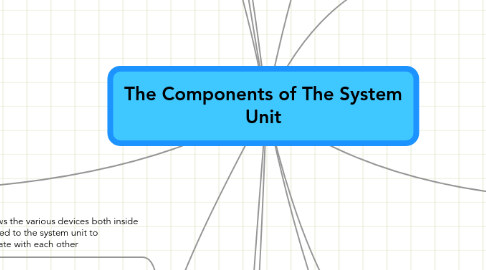
1. is a case that contains electronic components of the computer used to process data
2. Data Representation
2.1. Analog signals are continuous and vary in strength and quality
2.2. Digital signals are in one of two states: on or off
2.2.1. Most computers are digital
2.2.2. The binary system uses two unique digits (0 and 1)
2.2.2.1. Bits and bytes
2.2.3. ASCII (American Standard Code for Information Interchange) is the most widely used coding scheme to represent data
3. Memory
3.1. Memory consists of electronic components that store instructions waiting to be executed by the processor, data needed by those instructions, and the results of processing the data
3.2. Stores three basic categories of items
3.2.1. The operating system and other system software
3.2.2. Application programs
3.2.3. Data being processed and the resulting information
3.3. Each location in memory has an address
3.4. Memory size is measured in kilobytes (KB or K), megabytes (MB), gigabytes (GB), or terabytes (TB)
3.5. The system unit contains two types of memory
3.5.1. Volatile memory
3.5.1.1. Loses its contents when power is turned off
3.5.1.2. RAM
3.5.1.2.1. RAM chips usually reside on a memory module and are inserted into memory slots
3.5.1.2.2. Three basic types of RAM chips exist
3.5.1.2.3. The amount of RAM necessary in a computer often depends on the types of software you plan to use
3.5.2. Nonvolatile memory
3.5.2.1. Does not lose contents when power is removed
3.5.2.2. Flash memory can be erased electronically and rewritten
3.5.2.2.1. CMOS technology provides high speeds and consumes little power
3.6. Read-only memory (ROM) refers to memory chips storing permanent data and instructions
3.6.1. Firmware
3.7. Memory cache speeds the processes of the computer because it stores frequently used instructions and data
3.8. A PROM (programmable read-only memory) chip is a blank ROM chip that can be written to permanently
3.8.1. EEPROM can be erased
3.9. Access time is the amount of time it takes the processor to read from memory
3.9.1. Measured in nanoseconds
4. Buses
4.1. A bus allows the various devices both inside and attached to the system unit to communicate with each other
4.1.1. Data bus
4.1.2. Address bus
4.2. Word size is the number of bits the processor can interpret and execute at a given time
4.3. Expansion slots connect to expansion buses
4.4. Common types of expansion buses include
4.4.1. PCI bus
4.4.2. PCI Express bus
4.4.3. Accelerated Graphics Port
4.4.4. USB and FireWire bus
4.4.5. PC Card bus
5. Power Supply
5.1. The power supply converts the wall outlet AC power into DC power
5.2. Some external peripherals have an AC adapter, which is an external power supply
6. Keeping Your Computer or Mobile Device Clean
6.1. Clean your computer or mobile device once or twice a year
6.2. Turn off and unplug your computer or mobile device before cleaning it
6.3. Use compressed air to blow away dust
6.4. Use an antistatic wipe to clean the exterior of the case and a cleaning solution and soft cloth to clean the screen
7. Putting It All Together
7.1. Home
7.1.1. Intel Core 2 Duo or Intel Celeron Dual Core or AMD Sempron
7.1.2. Minimum RAM: 2 GB
7.2. Small Office/ Home Office
7.2.1. Intel Core 2 Quad or Intel Core 2 Extreme or AMD Athlon FX or AMD Athlon X2 Dual-Code
7.2.2. Minimum RAM: 4 GB
7.3. Mobile
7.3.1. Intel Core 2 Extreme or AMD Turion X2
7.3.2. Minimum RAM: 2 GB
7.4. Power
7.4.1. Intel Itanium 2 or AMD Quad Core Opteron or Intel Quad Core Xeon or Sun UltraSPARC T2
7.4.2. Minimum RAM: 8 GB
7.5. Enterprise
7.5.1. Intel Core 2 Quad or Intel Core 2 Extreme or AMD Athlon FX or AMD Athlon X2 Dual-Core
7.5.2. Minimum RAM: 4 GB
8. The System Unit
8.1. Drive Bay(s)
8.2. Power supply
8.3. Sound card
8.4. Video card
8.5. Processor
8.6. Memory
9. Processor
9.1. The processor, also called the central processing unit (CPU)
9.1.1. Multi-core processor
9.1.2. Dual-core processor
9.1.3. Quad-core processor
9.2. The control unit is the component of the processor that directs and coordinates most of the operations in the computer
9.3. The arithmetic logic unit (ALU) performs arithmetic, comparison, and other operations
9.4. The processor contains registers, that temporarily hold data and instructions
9.5. The system clock controls the timing of all computer operations
9.6. A processor chip generates heat that could cause the chip to burn up
9.7. Require additional cooling
9.7.1. Heat sinks
9.7.2. Liquid cooling technology
10. Expansion Slots and Adapter Cards
10.1. An expansion slot is a socket on the motherboard that can hold an adapter card
10.2. An adapter card enhances functions of a component of the system unit and/or provides connections to peripherals
10.2.1. Sound card and video card
10.3. With Plug and Play, the computer automatically can configure adapter cards and other peripherals as you install them
10.4. Removable flash memory includes
10.4.1. Memory cards, USB flash drives, and PC Cards/ExpressCard modules
11. Ports and Connectors
11.1. A port is the point at which a peripheral attaches to or communicates with a system unit (sometimes referred to as a jack)
11.2. A connector joins a cable to a port
11.3. A USB port can connect up to 127 different peripherals together with a single connector
11.3.1. You can attach multiple peripherals using a single USB port with a USB hub
11.4. Other types of ports include
11.4.1. Firewire port
11.4.2. Bluetooth port
11.4.3. SCSI port
11.4.4. eSATA port
11.4.5. IrDA port
11.4.6. Serial port
11.4.7. MIDI port
12. Bays
12.1. A bay is an opening inside the system unit in which you can install additional equipment
12.1.1. A drive bay typically holds disk drives
